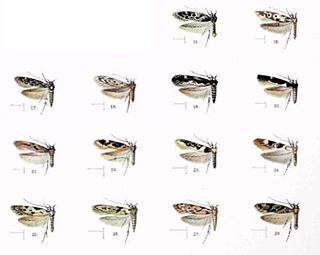
Scirpus is a genus of grass-like species in the sedge family Cyperaceae many with the common names club-rush, wood club-rush or bulrush. They mostly inhabit wetlands and damp locations.

The Momphidae, or mompha moths, is a family of moths with some 115 described species. It was described by Gottlieb August Wilhelm Herrich-Schäffer in 1857. These moths tend to be rather small with a wingspan of up to 21 mm. The wings are held folded over the body at rest. The larvae are concealed feeders, either as leaf miners or within seeds or stems.

Cyperus laevigatus is a species of sedge known by the common name smooth flatsedge.
Hyposmocoma cristata is a species of moth of the family Cosmopterigidae. It was first described by Arthur Gardiner Butler in 1881. It is endemic to the Hawaiian islands of Oahu, Molokai and Hawaii. The type locality is the mountains near Honolulu.

Hyposmocoma canella is a species of moth of the family Cosmopterigidae. It is endemic to the Hawaiian islands of Kauai, Oahu, Molokai and Hawaii.

Hyposmocoma liturata is a species of moth of the family Cosmopterigidae. It was first described by Lord Walsingham in 1907. It is endemic to the Hawaiian islands of Oahu and Hawaii. The type locality is Kona, where it was collected at an elevation of 4,000 feet (1,200 m).
Hyposmocoma lignivora is a species of moth of the family Cosmopterigidae. It was first described by Arthur Gardiner Butler in 1879. It is endemic to the Hawaiian islands of Oahu and Molokai. This is a common and widely distributed moth on Oahu.

Hyposmocoma montivolans is a species of moth of the family Cosmopterigidae. It was first described by Arthur Gardiner Butler in 1882. It is endemic to the Hawaiian island of Oahu. The type locality is the mountains near Honolulu.

Lantanophaga pusillidactyla, the lantana plume moth, is a moth of the family Pterophoridae. It is native to the southern United States, Mexico, the Caribbean and South America. It was introduced to Australia accidentally in 1936 and is now found from Sydney to Cairns along the coast. It has also been introduced to Hawaii in 1902, Pohnpei in 1948 and Palau in 1960 for biological control. It has since been recorded from Yap in 1987–1988 and is now distributed on all islands of the Mariana and Caroline Islands where the host plant is found, except Aguijan.
Trissodoris honorariella, the pandanus leaf perforator or pandanus hole-cutter moth, is a small cosmet moth species. It belongs to subfamily Cosmopteriginae and is the type species of the genus Trissodoris. Baron Thomas Walsingham in 1907 had specimens from both ends of the species' range – New Guinea and Pitcairn Island – which he described as separate species Stagmatophora honorariella and S. quadrifasciata in the same work. But his mistake was soon recognized, and when Edward Meyrick established the genus Trissodoris in 1914, he chose the former name to be valid.
Asymphorodes dimorpha is a species of gelechioid moth of subfamily Agonoxeninae of the palm moth family (Agonoxenidae), whose taxonomic status is disputed. Alternatively, the palm moths might be a subfamily of the grass-miner moth family (Elachistidae), with the Agonoxeninae becoming a tribe Agonoxenini.
Chedra microstigma is a tiny moth of the family Batrachedridae described in 1907. It has only been found on Oahu. It has been found feeding on sedges, plants belonging to the Cyperaceae family, and its larvae host at least three species of parasitoids in Hawaii.
Chedra mimica is a tiny moth of the family Batrachedridae known from Hawaii.
Trichophaga mormopis is a moth of the family Tineidae. It was first described by Edward Meyrick in 1935. It is widely distributed from Africa to India, Sri Lanka, Malaya, Taiwan and Fiji. It was first recorded from Hawaii in 1944.
Dryadaula terpsichorella, the dancing moth, is a moth of the family Tineidae. It is native to south-eastern Polynesia, Samoa and Fiji, but has also been recorded from Hawaii and more recently from Florida and California. The common name is derived from the characteristic dancelike gyrations it goes through when it alights. It was first described by August Busck in 1910.

Amorbia emigratella, the Mexican leaf-roller, is a moth of the family Tortricidae. Although it was described from Hawaii, it is known to be a native of the southern United States, Mexico and Central America. It was first described by August Busck in 1910.

Crocidosema lantana, the lantana flower-cluster moth or lantana tortricid moth, is a moth of the family Tortricidae. It was first described by August Busck in 1910. It is native to Mexico and the southern United States, but was introduced to Hawaii in 1902, Australia in 1914 and the Caroline Islands in 1948 and 1949 to aid in the control of Lantana weeds. It has also been recorded from Yunnan, China and in Sri Lanka.
Cremastobombycia lantanella, the lantana leaf miner, is a moth of the family Gracillariidae. It was first described by August Busck in 1910. It is native to the southern United States and Mexico. It was introduced to Hawaii in 1902 to aid in the control of Lantana plants.
Bucculatrix thurberiella, the cotton leaf perforator, is a species of moth of the family Bucculatricidae. It was first described by August Busck in 1914. It is native to the south-western United States and northern Mexico. It is an introduced species in Hawaii.
Acrolepia nothocestri is a moth of the family Acrolepiidae. It was first described by August Busck in 1914. It is endemic to the Hawaiian island of Oahu.








